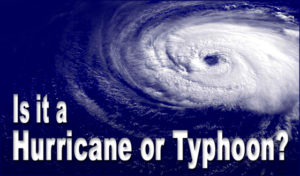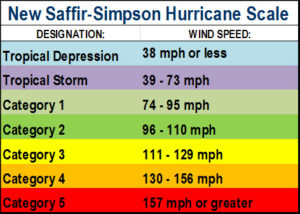Exploring the Difference between Hurricanes and Typhoons
Have you ever wondered, “What is the difference between hurricanes and typhoons?” Is a tropical cyclone just another type of hurricane?
Storms Threatening the U.S.
 In a bizarre weather anomaly, three potential hurricanes and a typhoon are now simultaneously threatening the U.S. and its territories:
In a bizarre weather anomaly, three potential hurricanes and a typhoon are now simultaneously threatening the U.S. and its territories:
- Meteorologists expect Hurricane Florence to strike the East Coast of the U.S. this week as a powerful Category 4 storm.
- Tropical Storm Isaac may reach hurricane strength before it careens into the Caribbean— endangering the U.S. Virgin Islands and Puerto Rico.
- Following closely behind Florence and Isaac, Hurricane Helene has reached a strong Category 2 level as of this posting.
- Typhoon Mangkhut, collided with U.S. interests in Guam. As of this posting, the monster storm has strengthened to a Category 4, with wind gusts of 165 m.p.h.
- Fortunately, Tropical Storm Olivia, now spinning toward Hawaii, has weakened from its earlier Category 1 strength.
When Do Hurricanes and Typhoons Become Major Storms?
All these storms begin as tropical cyclones: organized, rotating storm systems that develop over warm tropical water. At their births, meteorologists refer to all tropical and subtropical storms systems as tropical depressions.
If the storm grows in strength, the wind speeds increase. Once the sustained winds reach 39 M.P.H., the tropical depression upgrades to a tropical storm. If the storm intensifies to sustained winds of 74 m.p.h., it officially becomes a hurricane, typhoon, or cyclone.
 In addition, weather watchers keep a close eye on the barometric pressure of tropical storms. Pressure drops as storms intensify.
In addition, weather watchers keep a close eye on the barometric pressure of tropical storms. Pressure drops as storms intensify.
Hurricanes reaching Category 3 status or higher are considered dangerous major hurricanes. Typhoons reaching same level of intensity become super typhoons.
Location, Location, Location
In world of real estate, the maxim is “location, location, location.”
Oddly enough, location is also the difference between hurricanes and typhoons. Where it occurs determines whether the storm becomes classified as a hurricane, typhoon, or cyclone.
Meteorologists name robust storms originating in the North Atlantic, North Pacific, or Northeastern Pacific as hurricanes. If the same type of storm develops in the Northwest Pacific, it earns the designation of typhoon.
However, tropical storms occurring in the Southern Pacific or the Indian Ocean become tropical cyclones upon strengthening.
The International Date Line (IDL) determines the Northern Pacific designations between hurricanes and typhoons. Strong Pacific storms forming east of the IDL become hurricanes. The same size storm west of the IDL becomes a typhoon.
Interestingly, a few rare storms have managed to cross the IDL. When that happens, they retain the assigned storm name, but change classification.
For example, in August 2014, Hurricane Genevieve weakened back to a tropical storm, and then blossomed quickly into Super Typhoon Genevieve as El Nino conditions sent the storm across the International Date Line.
A year later, Hurricane Kilo became Typhoon Kilo when it crossed the IDL 700 miles south of Hawaii.
Building to Beat Hurricanes and Typhoons
Residents of coastal areas cringe when hurricane seasons approaches— especially at his time of year, when a major storm peaks.
Images from Hurricanes Sandy, Andrew, Rita, Katrina, and Harvey flood our brains and raise our blood pressure.
The only way to fight against nature’s furious storms is to build stronger structures, like RHINO Steel Building Systems.
Pre-engineering these structures to meet— or even exceed— all current local building codes, prepares these buildings to stand up to the storms and challenges of coastline living. RHINO structures have never been refused a building permit— even in hard-to-meet areas like Dade County Florida.
If you live and work in areas prone to hurricanes and typhoons, consider building with prefabricated metal building kits for your construction projects.
Learn more about our products and The RHINO Difference in metal buildings. Call RHINO today at 940.383.9566.
